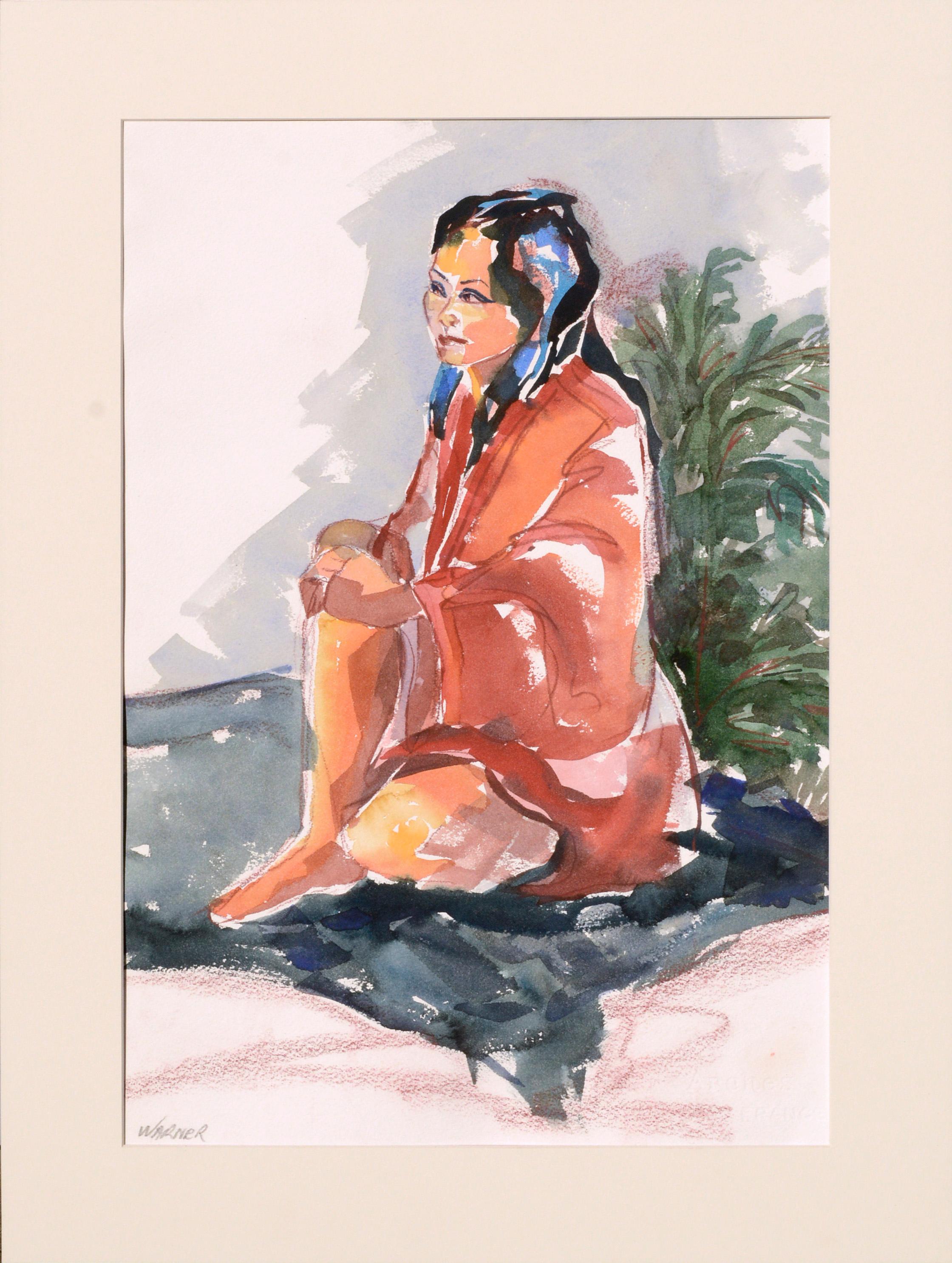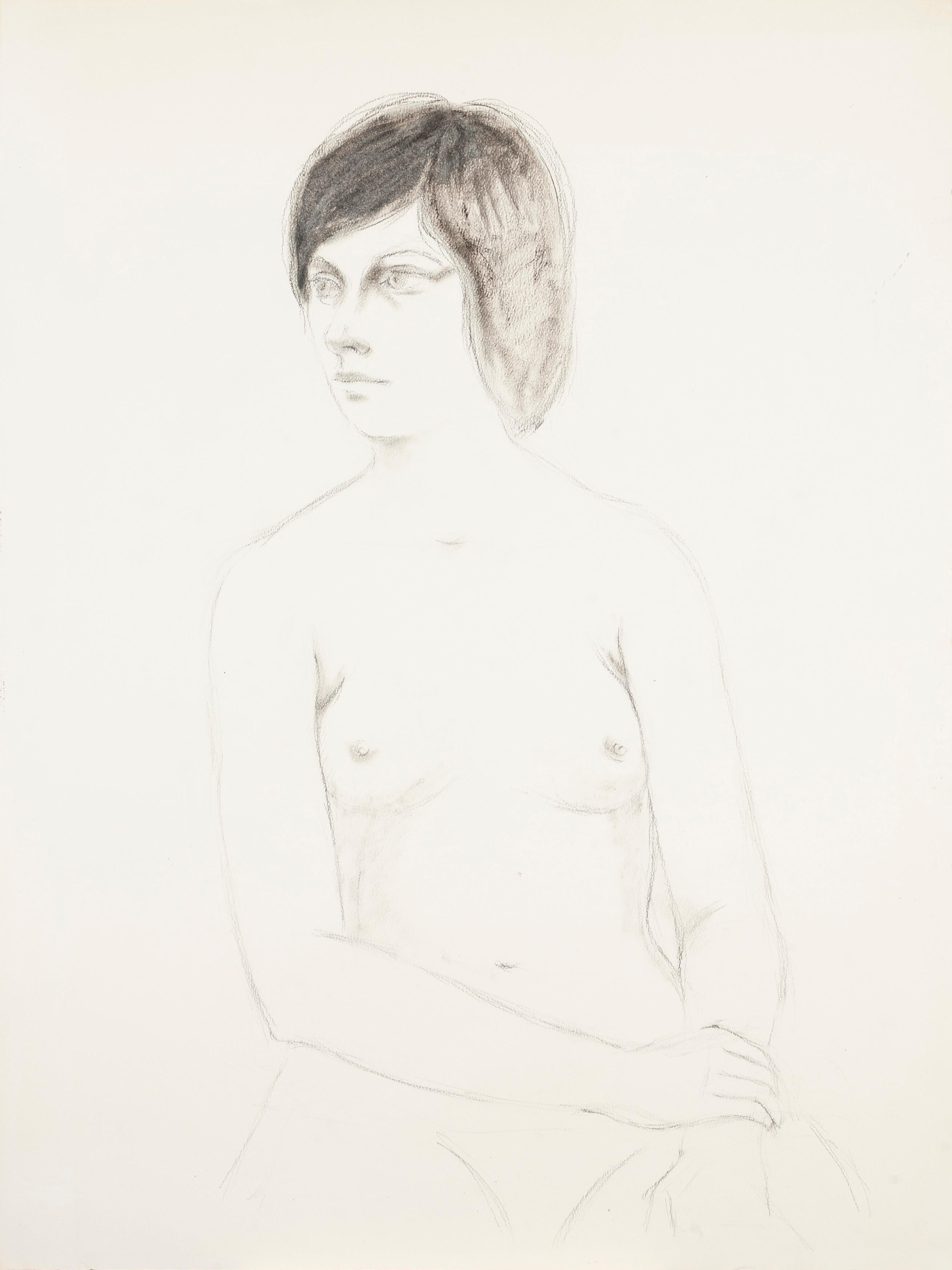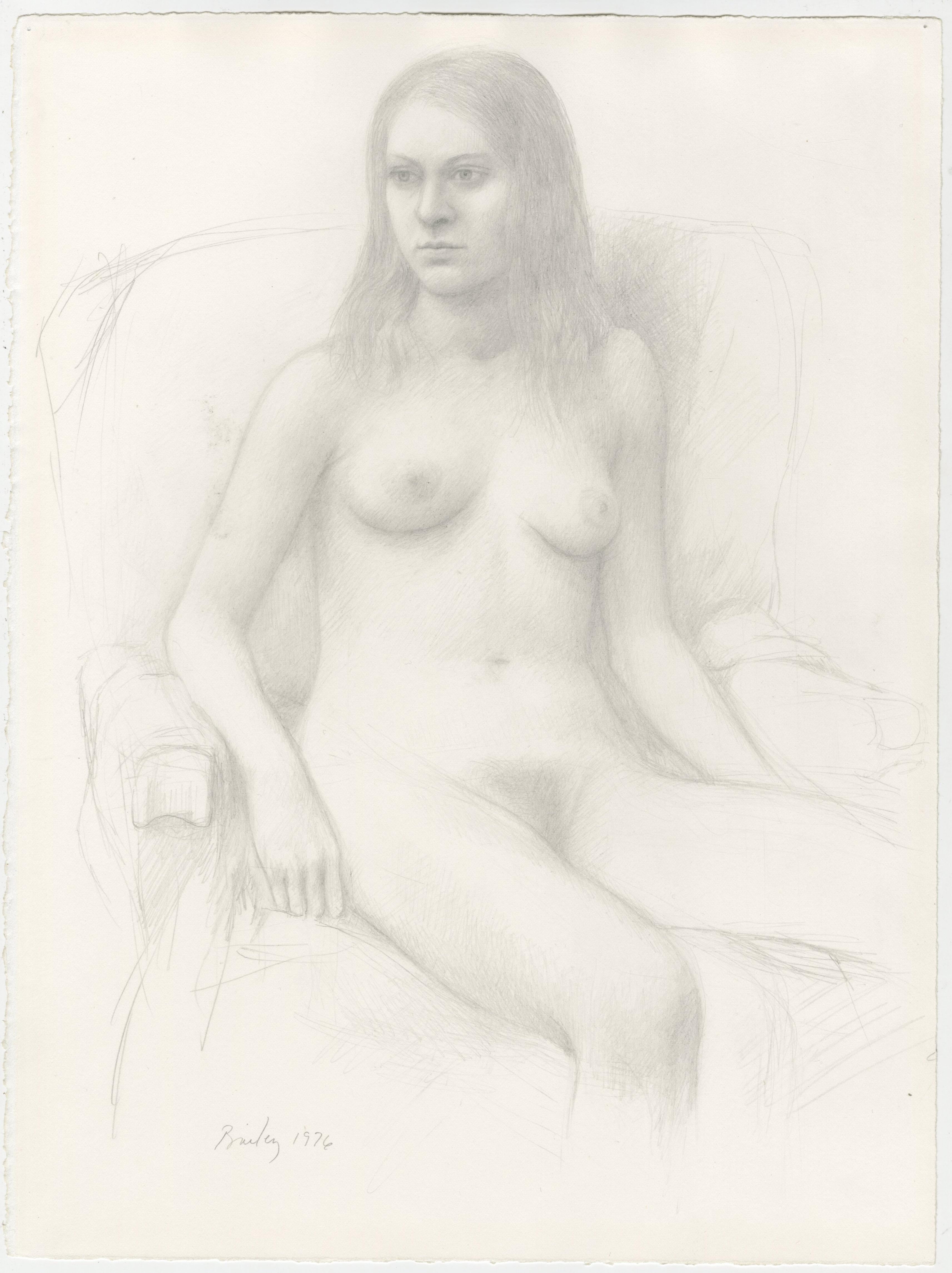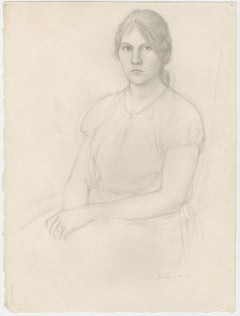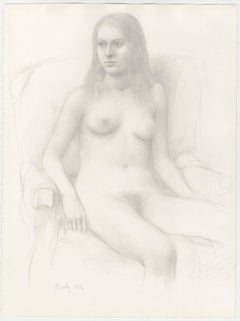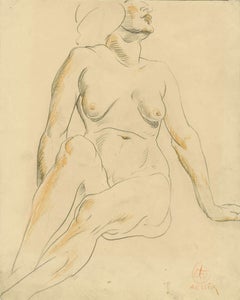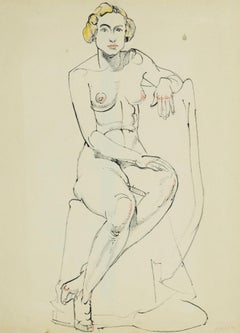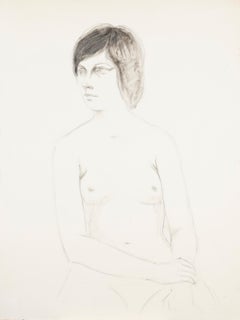Want more images or videos?
Request additional images or videos from the seller
1 of 8
William H. BaileySeated Woman, Left Hand to Chin1984
1984
$4,500
£3,401.13
€3,919.93
CA$6,349.50
A$6,997.59
CHF 3,663.47
MX$85,952.55
NOK 46,032.32
SEK 43,082.59
DKK 29,267.84
About the Item
Seated Woman, Left Hand to Chin
Graphite on laid paper, 1984
Signed and dated in pencil (see photo)
Provenance: Donald Morris Gallery, Inc. Birmingham, MI
Chernoff Estate, Bloomfield Hills, MI
Drawings by Bailey made in 1983 and 1984 represent one of the high points of his draftsmanship. This work is closely related to examples in Mark Strand's monograph, "William Bailey" (Abrams, 1987), nos. 31-32, 34, 36, 38-39. Bailey uses the same model in each of these drawings. Nos. 38 and 39 are titled "Study of C."
Condition: Excellent
Sight size: 19 x 13 1/4 inches
Frame size: 24-3/4 x 19-3/4 x 1-3/4 inches
William H. Bailey (American, b. 1930)
Born in Council Bluffs, Iowa, William Bailey became a painter in styles ranging from abstraction to super-real. He earned his B.F.A. and M.F.A. at Yale University and studied with Josef Albers and also had an Alice Kimball English traveling scholarship.
From 1962 to 1969, he taught at Indiana University, and from 1969, was a professor of art at Yale University.
He lives and works in Branford, CT and is a member of the National Academy of Design, elected an Associate in 1983, an Academician in 1994.
Recent one-person exhibitions include Robert Schoelkopf Gallery; Andre Emmerich Gallery; Robert Miller Gallery; Galleria il Gabbiana, Rome; and Galerie Claude Bernard, Paris. Selected group exhibitions include Realism Now, Vassar College Art Museum; 22 Realists, and 7 Realists, both at the Yale University Art Gallery; Decade in Review, Whitney Museum of American Art; and Contemporary American Realism Since 1960,at the Pennsylvania Academy.
His work is included in the collections of the Museum of Modern Art; Museum of Fine Arts, Boston; Des Moines Art Center; Art Institute of Chicago; Arkansas Art Center; Hirshhorn Museum; Pennsylvania Academy; St. Louis Museum of Art; Whitney Museum of American Art; and Yale University Art Gallery.
Publications on Mr. Bailey include "William Bailey", by Mark Strand, William Bailey, Hollander and Briganti; and "Art of the Real", Mark Strand & Clarkson Potter.
Mr.Bailey is the recipient of a Guggenheim Fellowship; Ingram Merrill Fellowship; and has been elected to the American Academy of Arts & Letters; and Academico, Academia Nationale, S.Luca, Rome.
Courtesy: AskArt
- Creator:William H. Bailey (1930, American)
- Creation Year:1984
- Dimensions:Height: 119 in (302.26 cm)Width: 13.25 in (33.66 cm)
- Medium:
- Movement & Style:
- Period:
- Condition:
- Gallery Location:Fairlawn, OH
- Reference Number:Seller: FA73661stDibs: LU14016450722
About the Seller
5.0
Recognized Seller
These prestigious sellers are industry leaders and represent the highest echelon for item quality and design.
Platinum Seller
Premium sellers with a 4.7+ rating and 24-hour response times
Established in 1978
1stDibs seller since 2013
809 sales on 1stDibs
Typical response time: <1 hour
Associations
International Fine Print Dealers Association
- ShippingRetrieving quote...Shipping from: Fairlawn, OH
- Return Policy
Authenticity Guarantee
In the unlikely event there’s an issue with an item’s authenticity, contact us within 1 year for a full refund. DetailsMoney-Back Guarantee
If your item is not as described, is damaged in transit, or does not arrive, contact us within 7 days for a full refund. Details24-Hour Cancellation
You have a 24-hour grace period in which to reconsider your purchase, with no questions asked.Vetted Professional Sellers
Our world-class sellers must adhere to strict standards for service and quality, maintaining the integrity of our listings.Price-Match Guarantee
If you find that a seller listed the same item for a lower price elsewhere, we’ll match it.Trusted Global Delivery
Our best-in-class carrier network provides specialized shipping options worldwide, including custom delivery.More From This Seller
View AllUntitled (Seated Young Woman)
Located in Fairlawn, OH
Untitled (Seated Young Woman)
Graphite on Veritable Papier d'Arches wove paper, 1970
Signed and dated lower right (see photo)
Condition: Excellent
Image/sheet size: 15 x 11 1/4 inch...
Category
1970s American Realist Figurative Drawings and Watercolors
Materials
Graphite
Nude Seated in Chair
By William H. Bailey
Located in Fairlawn, OH
Nude Seated in Chair
Graphite on paper, 1976
Signed and dated lower right (see photo)
Exhibited: Dart Gallery, Chicago, 1976 (see photo of label)
Condition: Excellent
Sheet size: 14 ...
Category
1970s American Realist Nude Drawings and Watercolors
Materials
Graphite
Untitled (seated female nude)
By Henry Keller
Located in Fairlawn, OH
Seated Femake Nude
Graphite and chalk on tan paper, c. 1920
Signed "Keller" and signed again with the artist's initials in a cypher
A finished life drawing most probably exhibited at...
Category
1920s American Modern Nude Drawings and Watercolors
Materials
Graphite
Seated Nude
By August F. Biehle
Located in Fairlawn, OH
Seated Nude
Match Stick ink drawing, c. 1925
Signed by the artist in pencil lower right: A. Biehle
Created at the Kakoon Arts Club, Cleveland. Influenced by friend and fellow artist...
Category
1920s American Modern Nude Drawings and Watercolors
Materials
Ink
Untitled (Seated Nude)
By Mary Ingebrand-Pohlad
Located in Fairlawn, OH
Signed in ink: Ingebrand
Drawings by the artist are in the collections of the Swope Art Museum, Terre Haute, IN and the Minnesota Museum of American Art...
Materials
Ink
Portrait of a Seated Woman
By Paul H. Winchell
Located in Fairlawn, OH
Portrait of a Seated Woman
oIl on canvas, c. 1930
Signed on the reverse in oil paint: "Paul W"
Created while the artist was a student at the Minneapolis Institute of Arts
Provenance: Estate of the artist
Condition: Cleaned and stretched by Monica Radecki, South Bend, Indiana.
The painting is unframed
Canvas size: 30 x 24 inches
This work created while the artist was in art school.
Winchell studied art at the Minneapolis and Chicago Art Institutes in the 1930’s. He went on to teach at both institutions. Winchell studied under the noted artists Daniel Garber and Leon Kroll. Winchell exhibited at the Minneapolis Institute of Arts, Art Institute of Chicago and the Kansas City Art Institute. He retired to a quiet life in Painsville, Ohio.
Paul H. Winchell (1903 – 1971) was a printmaker, illustrator, teacher, and gilder according to Crump, 2009 (Minnesota Prints and Printmakers, 1900- 1945, Minnesota Historical Society Press). He was the son of Mrs. Looman Winchell of Shepherd Rd as noted in a 1937 newspaper article (Painsville, O. Telegraph). Winchell grew up in North Perry, Ohio and then studied and worked as an instructor at the Art Institute of Chicago. He studied with Leon Kroll (1884 – 1974), Boris Anisfeld (1878-1973), Daniel Garber (1880 – 1958), Charles Woodbury (1864 – 1940), George Oberteuffer...
Category
1930s American Impressionist Figurative Paintings
Materials
Oil
You May Also Like
woman sitting
By Richard Royce
Located in San Francisco, CA
This artwork "Woman Sitting" 2013 is a pencil drawing on paper, by noted American artist Richard Benjamin Royce, born 1941. It is signed and dated at the...
Category
Late 20th Century Realist Nude Drawings and Watercolors
Materials
Pencil
Seated Woman Figurative Portrait
By Doris Warner
Located in Soquel, CA
Vintage watercolor portrait of a seated female figure with red robe in front of a plant by Doris Ann Warner (American, 1925-2010). Signed "Warner" in the lower left corner. Presented...
Category
1970s American Impressionist Figurative Drawings and Watercolors
Materials
Paper, Conté, Watercolor
Seated Nude
Located in Columbia, MO
Jerry Berneche (1932 - 2016) was a painter and draftsman of representational scenes and portraits featuring extraordinary color work and extremely detailed mark-making. Locally he is...
Category
20th Century American Realist Figurative Drawings and Watercolors
Materials
Graphite, Charcoal
Portrait Study of a Seated Woman
By Emile Lejeune
Located in Houston, TX
Portrait study of a woman seated with her dress coming off her body. She looks out at the viewer in a seductive manner. The work is signed and dated by the artist. The paper is not framed.
Many others are available. Please inquire to buy the entire collection.
Artist Biography: Emile Lejeune...
Category
1950s Naturalistic Figurative Drawings and Watercolors
Materials
Graphite
The Seated Woman - Drawing - Mid-20th Century
By Mino Maccari
Located in Roma, IT
The Seated Woman is an original drawing with ink on a creamy colored paper realized in the mid 0th century.
Monogrammed on the lower with the pencil.
Good conditions and aged
The ...
Category
Mid-20th Century Modern Figurative Drawings and Watercolors
Materials
Ink
The Seated Woman - Drawing by R. Fontene - Mid-20th Century
Located in Roma, IT
The Seated Woman is an Original ink and watercolor drawing realized by Robert Fonténé.
The artwork is in good condition on yellowed paper.
Hand-signed...
Category
Mid-20th Century Modern Figurative Drawings and Watercolors
Materials
Ink
More Ways To Browse
Gallery Seat
Painting Of Seated Woman
Josef Albers Signed
Baileys Vintage
Mark Morris
Vintage Vassar College
Andre Emmerich Gallery
William Holland
Used Kimball
Claude Bernard
H C Kimball
White Sewing Machine
William Saroyan
Adolphe Valette
Alice Beach Winter
Ancient Greece Figurative Paintings
Andres Garcia Benitez
Ardeshir Mohassess

